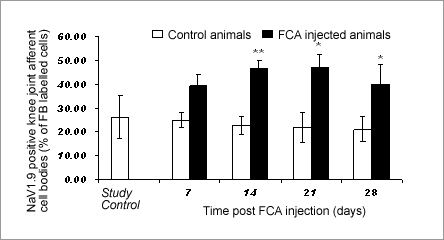Print version
Search Pub Med
Nav1.9 expression in a distinct population of knee joint afferents, in a rat model of chronic joint inflammation The expression of the sodium channel NaV1.9 has been shown to be altered in animal models of neuropathic and acute inflammatory pain (Tate et al., 1998) and its role has been implicated in the maintenance of inflammatory hypersensitivity (Priest et al., 2005). The aim of this study was to profile changes in NaV1.9 expression over a 28 day time course in a rat model of chronic inflammatory joint pain (Wilson et al., 2006). We used the fluorescent retrograde tracer Fast Blue (FB) to highlight a discrete population of knee joint afferents identifying a specific DRG neuronal profile. Male Wistar rats ( Charles River, n=54, 150-200g) were transiently anaesthetised using 3% isoflurane in oxygen, and FB (10µl, 20mg.ml-1) was injected into the joint space of the left knee. One week later test animals received an injection of Freund’s Complete Adjuvant (FCA; 150μl, 1mg.ml-1) into the same joint to induce chronic inflammatory joint hypersensitivity. Control animals received no FCA. Animals (FCA and control, n=6 per group) were culled on days 7, 14, 21 and 28 post-FCA, and ipsilateral L3-L5 DRGs were removed, immediately snap frozen and processed for fluorescent immunohistochemistry. Serial 12µm cryosections were cut, fixed in paraformaldehyde and labelled overnight with NaV1.9 primary antibody (GSK in house, 1:200). Sites of antibody binding were revealed using the secondary antibody; goat anti-rabbit-Alexa 488 (Molecular Probes, 1:200). In 5-7 sections of each DRG, the total number of FB positive cell bodies was counted, as was the number of those FB positive cell bodies which also expressed NaV1.9. The group mean co-localisation percentage (± SEM) was calculated from the total counts of L3-L5 for each animal (see Figure 1). At days 14, 21 and 28 there was a significant increase in the percentage of NaV1.9 positive knee joint afferent cell bodies innervating the hypersensitive joints (Mann Whitney, P<0.05 vs. control). These results provide further evidence that NaV1.9 channels may play a role in maintaining neuronal hyperexcitability in chronic inflammatory joint pain.
Figure 1. Percentage of NaV1.9 positive knee joint afferent cell bodies in control and FCA-induced knee joint hypersensitive animals over a 28 day time course study (n=6 per group, * = P<0.05, ** = P<0.01, Mann Whitney test)
Priest et al., 2005 Proc.Natl.Acad.Sci.U.S.A 102, 9382-9387. |
|


